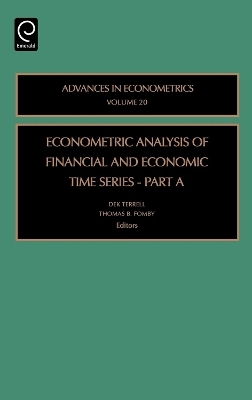
Econometric Analysis of Financial and Economic Time Series
JAI Press Inc. (Verlag)
978-0-7623-1274-0 (ISBN)
- Lieferbar (Termin unbekannt)
- Versandkostenfrei
- Auch auf Rechnung
- Artikel merken
The editors are pleased to offer the following papers to the reader in recognition and appreciation of the contributions to our literature made by Robert Engle and Sir Clive Granger, winners of the 2003 Nobel Prize in Economics. The basic themes of this part of "Volume 20 of Advances in Econometrics" are time varying betas of the capital asset pricing model, analysis of predictive densities of nonlinear models of stock returns, modelling multivariate dynamic correlations, flexible seasonal time series models, estimation of long-memory time series models, the application of the technique of boosting in volatility forecasting, the use of different time scales in GARCH modelling, out-of-sample evaluation of the Fed Model in stock price valuation, structural change as an alternative to long memory, the use of smooth transition auto-regressions in stochastic volatility modelling, the analysis of the balanced-ness of regressions analyzing Taylor-Type rules of the Fed Funds rate, a mixture-of-experts approach for the estimation of stochastic volatility, a modern assessment of Clives first published paper on Sunspot activity, and a new class of models of tail-dependence in time series subject to jumps. This series aids in the diffusion of new econometric techniques. Emphasis is placed on expositional clarity and ease of assimilation for readers who are unfamiliar with a given topic of a volume. It illustrates new concepts.
Introduction (D. Terrell, T. Fomby). Remarks (R. Engle, C. Granger) Part I: Multivariate volatility models. A flexible dynamic correlation model (D. Baur). A multivariate skew-garch model (G. De Luca, M. Genton, N. Loperfido). Semi-parametric modelling of correlation dynamics (C. Hafner, Dick Van Dijk, P. H. Franses). A multivariate heavy-tailed distribution for arch/garch residuals (D. Politis). A portmanteau test for multivariate garch when the conditional mean is ECM: Theory and empirical applications (C. Y. sin). Part II: highfrequency volatility models. Sampling frequency and window length trade-offs in data-driven volatility estimation: appraising the accuracy of asymptotic approximations (E. Andreou, E. Ghysels). Model-based measurement of actual volatility in highfrequency data (B. Jungacker, s. J. Koopman). Noise reduced realized volatility: a kalman filter approach (J. Owens, D. Steigerwald). Part III: Univariate volatility models. Modeling the asymmetry of stock movements using price ranges (R. Chou). On a simple two-stage closed-form estimator for a stochastic volatility in a general linear regression (J.-M. Dufour, P. Valery). The students t dynamic linear regression: Re-examining volatility modelling (M. Heracleous, a. spanos). arch models for multi-period forecast uncertainty a reality check using a panel of density forecasts (K. Lahiri, F. Liu). Necessary and sufficient restrictions for existence of a unique fourth moment of a univariate garch (P,Q) Process (P. Zadrozny).
| Erscheint lt. Verlag | 1.3.2006 |
|---|---|
| Reihe/Serie | Advances in Econometrics |
| Sprache | englisch |
| Maße | 156 x 234 mm |
| Gewicht | 747 g |
| Themenwelt | Wirtschaft ► Volkswirtschaftslehre ► Ökonometrie |
| ISBN-10 | 0-7623-1274-2 / 0762312742 |
| ISBN-13 | 978-0-7623-1274-0 / 9780762312740 |
| Zustand | Neuware |
| Haben Sie eine Frage zum Produkt? |
aus dem Bereich


